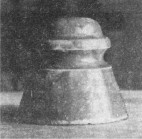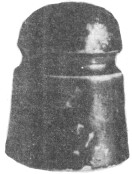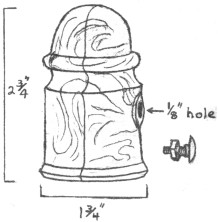Porcelain Insulator News
by Jack H. Tod, NIA #13
Reprinted from "INSULATORS - Crown Jewels of the Wire", April 1979, page 23
Dear Jack:
I am sending photographs of two porcelain
items I acquired recently. They are both Fred M. Locke items which I picked up
at local antique shops.
The first is this small Fred M. Locke with a very clear
marking. It has an interior petticoat and, as you can see from the photo, it has
a caramel or golden tan glaze. I have seen it in Gerald Brown's book "Fred
M. Locke and His Insulators", but it mentions it in white glaze. How
unusual is it in this tan color, and could you give me an idea of its value?

The
second item is a Fred M. Locke pony, marking on crown, approximately 2-15/16" by 3" tall. This one has a black porcelain glaze, and I think
the photos show clearly that it is truly black and not just a very dark brown.
How unusual is the black porcelain glaze? Any idea of its value?
Len McCowan
Webster, N.Y.

- - - - - - - - -
Dear Len:
You really hit the jackpot finding these two Fred Locke
item in antique shops. How lucky can one be? The first item (brown glaze) is a
U-259. These are a rare Fred Locke item, and the several specimens I know of are
white glazed. Thus, yours with the light brown glaze is a new report to me of
such an animal. Its value would be in the order of several pints of Type A blood
(figured at about $25 a pint).
The Fred Locke pony with black glaze is a real
puzzler to say the least. I've never heard of any Fred Locke porcelain item with
a black glaze. If this is an authentic, original, factory glaze (as opposed to
someone's basement operation of recent years), this specimen will raise a lot of
eyebrows in the circle of Fred Locke specialists.
(The specimen has since
been authenticated per my suggestion by Lew Hohn of Rochester, N.Y. -- and see the
following letter from Lew. Len also later sent color photos of two other Fred
Locke ponies, possibly from the same source. One has a rich mahogany-brown
glaze; the other has a mottled greenish-brown glaze with heavy black banding at
the three heavy glaze points -- above the wire groove brow, bottom portion of the
wire groove, and above the insulator base rim.
(These could be the key to the
black one also; that is, a combination of an experimental derivation of the new
mahogany glaze type adopted in about 1904 and an improper firing of an improper
glaze formula.)
The original Fred Locke ponies cataloged in 1899-1900 were this
general shape but much larger (base diameter 2-1/2", nominally Similar
U-18), and these were the Locke #6. By 1902 the Locke #6 pony had changed shape
to the U-38 sort of thing with a base diameter of only 2". The design then
was changed to a similar shape (U-39) but with a diameter increase to
2-1/4" This is the most common Fred M. Locke pony style.
Shortly thereafter
(by 1904), the design changed to the U-3 style (as yours is) with 2-5/16"
diameter and a rounded crown, and the catalog number was changed to #9. That
design and numbering was continued until Locke ceased cataloging the pony
insulators in the 1930's.
Each of your Fred Locke U-3 pony insulators would be
considered a good item both because of their color and of the Fred Locke marking
on that pony style, but Locke specialists would really fight over that black
one. Its value would depend on the size of the winner's bankroll! You might say,
when it comes to Fred Locke insulators, "black is beautiful".
Jack
(MORE)
Dear Jack:
Len McGowan was over last evening and brought a real jewel he had
written you about, and which you wanted me to authenticate. It is really and
originally black. It's a deep blue black where the glaze is thinner, but is
authentic. The edge of base where the glaze was fettled off for firing is normal
and reinforces its authenticity as an original Fred Locke item. The inside
threads are glazed as well, as is normal for U-39 and U-3 styles of Fred M.
Locke ponies. I have the U-3's in brown shades. These are not as common as
U-39's but are available -- scarce, I would say.
By the way, I just added a dark
cobalt blue U-802A Locke #99 Hi-Top. Also a Thomas U-757 in a very dark blue
with a shiny black radio-treated top. How about a U-630A by Victor Insulators,
Inc. (rectangle-V marking) in dark forest green and lastly, a green Lapp U-300?
In the Sept. 1978 column you discussed known glaze colors on
transpositions by Westinghouse and Ohio Brass Co. Here are three I have in
addition to those: U-206 Westinghouse (incuse marking) in white; U-206
Westinghouse (unmarked) in cobalt blue; U-206A Ohio Brass Co. in white.
Lew Hohn, NIA #1135
Rochester, N.Y.
- - - - - - - - - -
(Lew has probably seen and studied more Fred M.
Locke insulators than anyone else and undoubtedly has one of the finest
collections of Fred Locke items. I consider him an authority on the subject. If
Fred Locke ever made an insulator with the pinhole sideways though the body, Lew
could not only describe it for us but could probably also point it out for us on
his many shelves of insulator goodies.
Jack)
Michael McLaughlin (Warsaw, Ind.)
also reported a while back that he got some nice porcelain additions at a show
last fall, and one of these was a cobalt blue Locke #99 Hi-Top. The Locke #99 is
a spectacular insulator even in brown, so it must be a very pretty thing in
cobalt blue.
Dear Jack:
... My interest comes and goes in insulators, but still
plugging along after almost six years in the hobby. No more "startling
finds" in the porcelain world up here, although I did dig up six of the
U-225B bottom half of the U-225 two-piece transpositions (3 or 4 mint) three
years ago. Would you believe these bottom parts had been used as regular
insulators on a single, two-wire, telephone line that had been abandoned in the
1920's and poles rotted away in the ground? Six successive poles with short,
two-insulator crossarms had a pair of the U-225B bottoms on them, but six were
totally crashed in the ground and couldn't even be glued back together. If I
could just find the U-225A tops now!! Believe me I've looked the last three
years but not a sign that the tops ever existed here, I find it hard to believe
that a company would have shipped the bottoms up here without the tops, but
guess we'll never know. Let me know if you ever run across anyone who would like
to trade a nice mint top for a mint bottom part or some other insulators.
...
Have been meaning to write you for a long time about my find of MACOMB
transpositions in the winter of 1972-73. (Beginner's luck!) I found eleven of
these beauties at one old river crossing, all virtually mint. One had a factory
abrasion on the skirt and a couple had the tiniest of base or wire groove chips.
I believe you may be wrong on the relative scarcity of these two tramps though,
Jack, as 9 of the 11 were the old U-197's with poorly aligned threads in both
parts (of the glazeweld). I still have the most beautiful, absolutely flawless
pair in my collection and will probably hold on to them forever. All the others
went for $125-150 cash each years ago.
...Oh yes, I did pick up a nicely marked
"N.A.T.Co." U-148 porcelain beehive (mint) in a junk shop for $4 once,
but passed up a second one very near mint at $3, as I didn't then realize what
it was. Live and learn!!
Bernard Warren
Anchorage, Alaska
- - - - - - - - -
Dear Bernard:
... Regarding your U-225D tramp bottom halves, it could be just the other way
around, and maybe you'll be able to locate some top parts. The tops of these
were at times used for regular insulators and the bottom parts discarded. If the
tops got used that way in your area or elsewhere, the bottoms would have been
the leftovers and thus given away to another utility as scrap or used as a last
resort at one time in your area. I don't disregard the possibility that both the
tops and bottoms were used in the same general area by the same utility. (I once
had several top parts which were found in use as regular insulators, and I never
had any luck in finding extra bottoms, so you can have hope.)
... I don't really
think I disagree with what you say about the MACOMB tramps. Value on these
items, as well as any other insulators or any other thing for that matter,
depends on supply and demand. The supply is obviously very limited, but the
demand is very great. I know of those you found, plus some in New Mexico, plus 4
or 5 in Nebraska, plus etc. Yet demand is very much greater. Not only are they
an unusual shape, but they match a shape which is scarce to rare in glass. They
also are a key item in the MACOMB set of pin types which are popularly collected
by many who have the pocketbooks to try for the entire set, and are the only
porcelain pin type for communications work were made by glazewelding. Lastly,
for those who collect general of porcelain transpositions, the U-197's are
sought after just as much as the rare two-piece types and the very rare U-198.
Certainly that's a lot going for the MACOMB tramp. I sold my U-197A several
years ago and, even though it had a repaired chip in the top skirt, the buyer
was still glad to get it for $125.
... I beat you on the N.A.T.Co. items. I saw
a long row of porcelain beehives on a high shelf in an antique store once with
$1 stickers, and I looked at a few before quitting. But then, saying
"what-the-heck", I got up on a chair and looked at all the others. The
last one I came to was a perfect "N.A.T.Co.". I paid my $1 and said
"thank you" as I left!
Jack
Dear Jack:
Saw your porcelain
insulator book ad in Crown Jewels, but noticed it was listed as a Second
Edition, 1976. I promptly dug out my copy to check the date of publication, and
it was 1971 (first edition).
Are there a lot of changes, additions or info in
the 2nd edition that are not in the first edition and which would warrant my
purchasing the newer edition?
I enjoy reading your articles in Crown Jewels each
month. I am a general collector, and it is only the last 2 years that I have
started collecting a number of porcelain insulators.
I notice by the fly leaf in
your 1971 book that you were in electrical engineering. What particular field? I
am (or started out) in the electrical engineering field. I worked for English
Electric Co. and was on power transformer design up to 15-20,000 Kva
(Kilo-volt-amperes), usually 34.5 to 66 Kv class. I have seen a lot of
insulators in my time, but usually of the transformer type.
Actually, I haven't
come across a great deal of porcelain insulators in my travels to antique or
junk shops. We have a bottle/insulator show in the spring and fall at Niagara
Falls, and I pick up most of my insulators from there. We have a show coming up
in March, so I will probably be able to pick up a few more.
Phil Adshead
St.
Catherines, Ont., Canada
- - - - - - - - -
Dear Phil:
It worked out as originally planned. The
1971 book was a strike-off point, to be followed by supplements and eventually a
2nd edition. Once the first book came out, others then knew which remaining
items we didn't know of, etc. There were three supplements (1972, 1973, Jan.
1975), plus even more info by the 2nd edition time in 1976. Even though some
small amount of new info has trickled in since, and will also in the future, the
2nd edition has probably 95% of the info that'll ever turn up -- Style Chart
shapes, markings, history information, etc.
The 2nd Edition has about 50% more
total info (markings, shapes, etc.) than the 1971 edition. It also expands on
and corrects some of the other material of the 1971 edition -- mostly in line
with contents of the supplements, but some from key material only published
previously in Crown Jewels articles. Trust that the above info on content will
be helpful.
I was an electronics design engineer -- in the tube era before
semiconductors made the big takeover. I was with Motorola, Inc. (Phoenix)
1950-60. My insulator collecting therefore wasn't related, but my desire for
accurate info on manufacture, use etc. certainly was. Before I got into the act,
there was considerable erroneous info that got published! I've collected many
things in my life, and insulators just found their way into my list of
collecting interests.
Other than knowledge from college courses plus what I see
in use and in catalogings, I'm rather ignorant of power equipment design. I've
always had a real yearning to see just what's inside a very HV transformer, not
to mention other items such as generators, etc. Designing for voltages of 235 Kv
or higher must be a real challenge in many ways. Even more so with power ratings
such as the 20,000 Kva you mention. As you can imagine, all this design is very
foreign to my past electronics design work where milliwatts and microwatts was
the norm! I was involved in the Govt. Military Electronics Div. here -- mostly
missile and satellite work. We didn't do work on commercial equipment in my
plant here.
Enjoyed hearing about your chasing after insulators up there,
at shows etc. I suggest you might also be able to get a few old porcelains if
you have any contact with utilities in your area or travels. Some of them have
in back rooms or piled out in the back some nice old items that they've salvaged
from older lines they have pulled down or rebuilt.
Jack

Dear Jack:
I bought this
insulator at an antique shop. It is an opaque and very pale green glass with
grass-green swirls. It is "threadless", has a Mold-Line-Over-Dome,
and a small hole in the side through which a bolt and nut are attached. I would
really appreciate any information you could give me about this insulator.
Walter
L. Kropf
Rt. 2
Mexico, MO 65265
- - - - - - - - -
Dear Walter:
These have been reported several
times before, and was in CJ magazine October 1972 the last time as far as I
know.
The consensus of opinion on these has always been that they were sold as
ashtrays for use in automobiles. The bolt holds a metal band on which is
attached a rubber suction cup. Neither Dora nor I like to admit that we are also
antiques like these gadgets, but we both seem to recall seeing these mounted on
the dashboards of our folks' 1926 Buicks.
I'm still not convinced these things
are portions of old auto ashtrays, so let's just refer to them as
"Whatisits" until we find out their true use with certainty.
Jack
| 